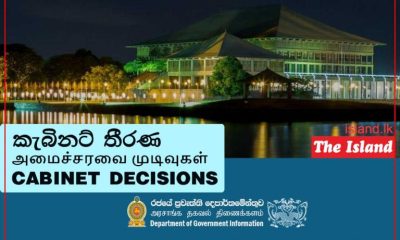Business
Stripes and Checks celebrates milestone expansion

Stripes and Checks (Pvt) Ltd, is a leading menswear clothing brand in Sri Lanka born from the collective vision of three friends—Gajan Vinothan, Kalana Jayasuriya, and Udara Rathnayake. Emerging almost a decade ago, thy have built a brand that goes beyond mere garments where it represents individual styles, creativity, and a dedication to quality.
Over the years Stripes and Checks has evolved into a prominent player in menswear, catering to over a 30,000 loyal customer base. The company has a team comprising over 50 dedicated individuals united by a common vision to delivering unparalleled service and crafting garments of the highest quality.
Stripes and Checks (Pvt) Ltd offers a comprehensive selection of menswear, encompassing both formal and casual attire. The collection includes a variety of formal and casual shirts, ranging from classic whites to vibrant prints, sophisticated stripes, and timeless checks. With an extensive range of fabrics, the brand provides a diverse range of options to cater to different preferences and styles. In addition to its shirt collection, Stripes and Checks offers a unique collection of polo t-shirts, Chinos, regular t-shirts and men’s accessories. As a brand committed to supporting local talent, all items are proudly manufactured in Sri Lanka.
Business
‘A meeting of minds, markets and opportunities’

The Global Franchise Forum 2025, held at the Sheraton Hotel in Colombo recently was seen by dignitaries present as delivering significant benefits to Sri Lanka’s economy, entrepreneurs and the country’s global standing. Gaurav Marya, chairman, Franchise India Group, complimenting the event said, among other things, that the event was a ‘meeting of minds, markets and opportunities’.
The event attracted global brands, investors and business leaders, connecting them with Sri Lanka’s entrepreneurial community and was seen as laying the groundwork for long-term economic growth and collaboration.
Gaurav Marya, further said:
“We are thrilled to see such an enthusiastic and relevant audience in Sri Lanka. The energy in the room reflected the hunger for growth and the readiness of Sri Lanka’s entrepreneurs to embrace global brands and scale with purpose.”
Knowledgeable observers added: ‘Franchising offers a tested pathway for small and medium enterprises (SMEs) to grow sustainably. Through partnerships with established global brands, Sri Lankan entrepreneurs now have better access to proven business models, reducing startup risks and improving scalability. This promises to generate significant employment opportunities in sectors like hospitality, healthcare, retail, and education, thereby strengthening the social and economic fabric of the country.
“The forum also helped reinforce Sri Lanka’s strategic position as a gateway to South Asia. Highlighting the country’s growing consumer base, skilled workforce and improving business environment, the event attracted international attention, signaling Sri Lanka’s readiness to play a larger role in regional trade and investment flows.
“Support from respected organizations—including the Indo-Lanka Chamber of Commerce, ICC Sri Lanka, and FCCISL—helped foster new partnerships and cross-border collaboration opportunities. By encouraging foreign investment and knowledge-sharing, the forum is set to help Sri Lankan businesses become more competitive regionally and globally.
“Panels, workshops, and one-on-one business meetings equipped attendees with vital knowledge about franchising strategies and global business practices. The presence of industry experts offered Sri Lankan entrepreneurs valuable tools for success, promoting a culture of innovation and strategic growth.”
Reflecting on the broader significance of the event, Gaurav Marya added,
“Sri Lanka is clearly moving toward economic recovery. Despite global headwinds, including recent trade policy shifts, the Global Franchise Forum 2025 Sri Lanka Edition has helped catalyze timely conversations and build sustainable partnerships that support long-term economic development and resilience.”
By Ifham Nizam
Business
National Savings Bank appoints Ajith Akmeemana,Chief Financial Officer

National Savings Bank (NSB) announces the appointment of Ajith Akmeemana as the Chief Financial Officer (CFO), effective immediately.
Ajith Akmeemana has nearly 35 years of experience in the financial services industry driving financial strategies and ensuring sustainable organizational growth and profitability.
He brings extensive experience in corporate planning, asset-liability management, treasury management and corporate finance activities, complemented by C-suit leadership roles at Nations Trust Bank and Bank of Maldives. His career commenced at Standard Chartered Bank, Sri Lanka, and includes a strong foundation in audit and advisory services at Ernest & Young.
Akmeemana is a Fellow Member of the Institute of Chartered Accountants of Sri Lanka and holds an MBA from the University of Manchester, UK. He is also a Graduate Member of the Sri Lanka Institute of Directors and an Associate Member of the Institute of Bankers of Sri Lanka.
Commenting on his appointment, Akmeemana said, “It is an honor to join National Savings Bank, an institution with a strong legacy and an essential role in Sri Lanka’s financial sector. I look forward to supporting NSB’s mission and contributing to its continued growth and success.”
The Chairman, Board of Directors, GM/CEO, and the entire NSB team warmly welcome Akmeemana and are confident in his ability to lead the Bank’s financial operations in alignment with its strategic direction.
Business
SriLankan Airlines celebrates International Pilots’ Day

SriLankan Airlines marked International Pilots’ Day on 26 April 2025 with a small gathering at its Flight Dispatch Centre at Bandaranaike International Airport. Pilots were presented with a special vehicle badge bearing the iconic winged emblem, in appreciation of their enduring dedication and flying spirit that keeps the world connected every day. The event, which treated guests to pilot-themed cupcakes, offered a moment to reflect on and celebrate the extraordinary efforts and sacrifices pilots make in bringing the world closer together.

-

 News7 days ago
News7 days agoOrders under the provisions of the Prevention of Corruptions Act No. 9 of 2023 for concurrence of parliament
-

 Business2 days ago
Business2 days agoPick My Pet wins Best Pet Boarding and Grooming Facilitator award
-

 News6 days ago
News6 days agoProf. Rambukwella passes away
-

 News2 days ago
News2 days agoNew Lankan HC to Australia assumes duties
-

 Features2 days ago
Features2 days agoKing Donald and the executive presidency
-

 Business2 days ago
Business2 days agoACHE Honoured as best institute for American-standard education
-

 Features4 days ago
Features4 days agoThe Truth will set us free – I
-

 Features6 days ago
Features6 days agoThe sea-change after Modi’s visit















